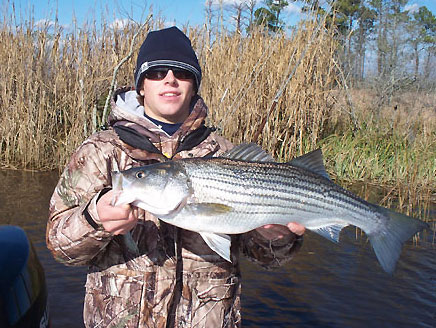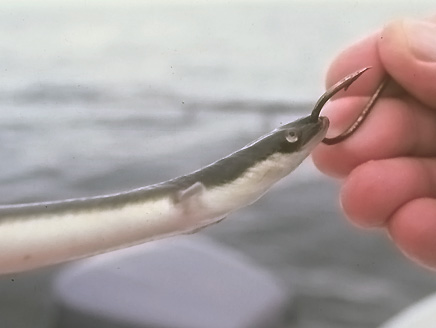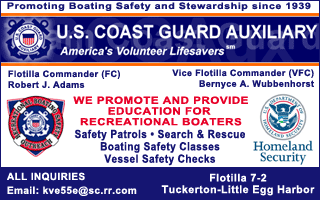

Keep the plugs in the Tackle Box...Early Season is the Time to Break Out the Bait!
Story by Tom Vassallo
The Fall Run may still be pretty fresh in your mind as the spring striper season approaches. Visions of big fall linesiders smashing plugs makes any striper angler's heart flutter, but March is certainly not fall, and though it is technically spring, actually it sometimes feels very much like winter. New Jersey's brisk late March wind and cold temperatures can keep some striper anglers sitting close to the fire...and they may wait a bit until the news of spring bunker and much warmer water gets them rushing for the beaches and boats with their plugs and bunker spoons. However, if you're one of those anglers who doesn't want to wait to get that first striper of the season, you'll need to forget those fall techniques and employ early spring techniques to land that first early season striped bass.
All game fish are under the control of one Mother Nature. What you need to take from that is that the lower winter sun and cold air temperatures keep the water temperatures cool for most of March and even into early April. Those water temperatures are going to control how the fish move, react and feed...it's as simple as that. Although some fishing lure purists will argue that you simply need to slow down your lures or slowly drift and hop plastics on the bottom in colder temperatures...the simple fact is that early spring is BAIT time. That's right...I said it. Now I can almost hear the painful cries of the bunker spoon and bucktail addicts...sorry guys...bait is where it's at for really early bass.
 |
| Best spots for early season baitfishing for stripers can be found in shallow bay feeder creek areas and estuaries that will warm faster than the really deep holes. These fish are usually year round resident juveniles, but an occasional keeper will be found in those schools. |
We are not talking about big migratory bass however. Many anglers simply forget that striped bass are here in New Jersey waters all year round. If you understand the biology of the striped bass, you know that the bass do not begin to migrate until they are about 30" in length. That means that mixed in with the smaller schoolie holdover bass are some legal sized fish. These fish prefer a water temperature between 55-65 degrees. Yet in late winter, that is not a temperature that is easily found. However, these fish will feed in temperatures as low as the mid-40 degree temperature range. In temperatures below that, some striped bass will enter a state of "torpidity". "Torpor" is a state where fish will not feed, become lethargic and almost in a hibernation-type state. These temperatures will usually be seen in February when areas like Barnegat Bay may see temperatures below freezing. So the key to finding feeding fish is finding water that has risen to between 45-50 degrees. That is when the striped bass will begin feeding.
Simply because striped bass begin feeding does not mean that these fish will become highly active and begin striking at surface lures voraciously. They will certainly be moving slower in water that is at or below 50 degrees. That is why it makes a heck of a lot more sense to drift some bait slowly by these lethargic fish than to head out and start buzzing plugs on the surface. Look for areas where water will warm faster. Holes along sod banks where darker mud bottoms will feed warm water into the holes as the sun begins to rise higher during the day. Also areas around power plants will stay warmer throughout the winter. The Oyster Creek in Ocean County is a very popular early season spot due to the discharge from the plant into the Oyster Creek. A good barometer of that theory is that for the past two years, the first striper of the year has come from those warmer waters. A more scientific way to check the bay temperature is to use the National Water Information System to check water height and temperature. This is the link for Barnegat Bay - http://waterdata.usgs.gov/nwis/uv/?site_no=01409125
Once you know the water temperature is warm enough for fish to be biting, it's time to get your bait and rigs ready to go. The early spring baits are the old tried and true baits of the "old timers". Clams, bloodworms and live eels (if you can get any!) are great baits to try the waters and see if the stripers have started feeding. Probably the best rig to use is a high-low rig to determine the depth that the fish are feeding at. Keep your bottom hook and leader as close to the bottom as possible. Tie up some rigs with your high hook one foot above your bottom hook and also tie a couple of other rigs with your upper hook at two feet. Your leaders should be heavier line, especially if you will be fishing in strong currents. That's the simplest way to determine the depth the fish will be feeding at. If you are going to be using bloodworms, use 4/0 baitholder or 4/0-5/0 Gamakatsu Octopus hooks. You should only require about 1-2 ounces of weight depending on the tide or current. Thread the bloodworm onto the hook and over the eye to the line. Let a portion of the worm dangle off the hook for some movement. If you'll be boat fishing, you may want to use a conventional rod. Stripers have a subtle hit that is hard to feel when they are in colder water. It is also helpful to hold the line in your fingers while free spooling. When you feel a light bump or two then feel a little more weight, set your clicker and that should help set the hook.
If you are going to use clams, chances are they may be frozen, salted ones from last year's bait still in the freezer. Otherwise, you may be able to buy a bucket of frozen ones from your local bait & tackle dealer. Thaw them early before heading out...it takes a while to thaw a bucket in March! It is best to chum with some of the clams and juice to get the scent in the water. Try to find a spot where the current is running along a sod bank. Use a fish finder rig with an 18" - 24" leader. The barrel swivel will help to keep your line from getting twisted. Use a circle hook to help keep the fish from getting gut-hooked. Some anglers also like to use no weight and let the hook and bait fall with the chum. It may also help to use some thread to keep your clam fastened to the hook. It will be more difficult for the fish to steal it that way!
 |
| If you are lucky enough to get your hands on some small early season eels...these can be deadly and should attract the larger fish in the school. |
If you are lucky enough to get your hands on some small eels, you may be able to persuade some of the larger juvenile bass to partake. A fish finder rig is the ticket here as well. Depending on the current, you may have to really use some heavier weight. You want to keep the eel down at the bottom as much as possible. You will be surprised at how light the "tap-tap" of the take is when “eeling”. When fishing with friends a few years back, we were eeling at midnight in the bay and it was difficult to feel a 20 pounder take the bait. It is very subtle. Therefore, you will probably find the smaller fish even more difficult to feel.
So there you have it...forget the plugs in early season cold water and bait up for action when in search of your first bass of the season. You'll probably land a lot more fish and you could have stripers a lot earlier than you would if you stick to the old cast and crank routine. Now get out there and fish!














